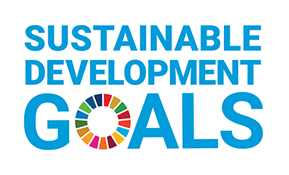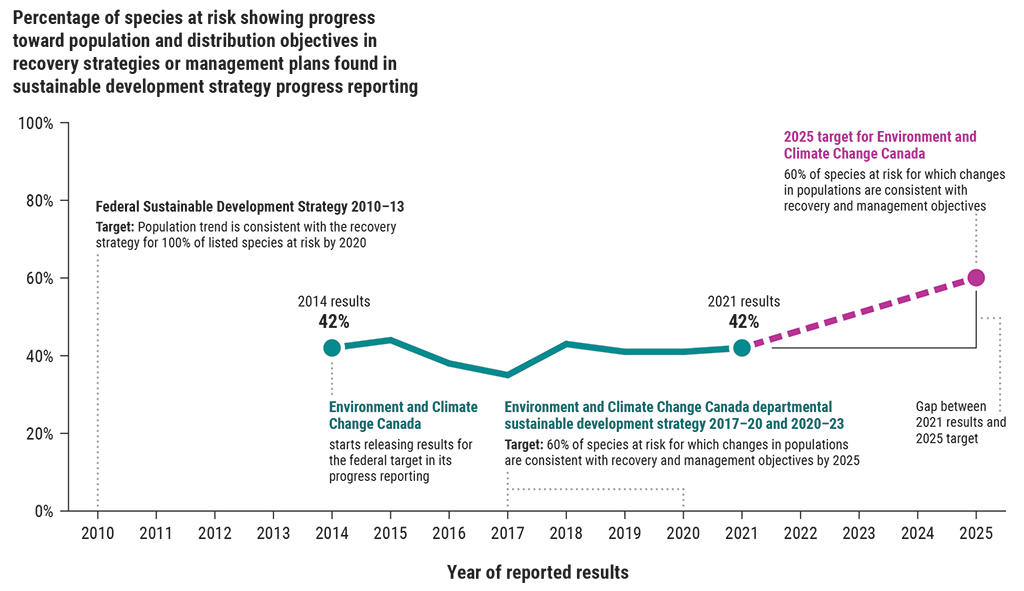2022 Reports 6 to 10 of the Commissioner of the Environment and Sustainable Development to the Parliament of Canada
Report 9—Departmental Progress in Implementing Sustainable Development Strategies—Species at Risk
At a Glance
Overall, Environment and Climate Change Canada, Fisheries and Oceans Canada, and Parks Canada contributed to the federal species at risk target under the Healthy Wildlife Populations goal in the 2019–2022 Federal Sustainable Development Strategy by identifying in their individual sustainable departmental strategies actions that they planned to take and aligning those intended actions with the federal strategy. However, these actions did not fully support meeting the federal species at risk target because the organizations’ strategies did not include some conservation and recovery activities that are needed to track and demonstrate progress in these areas. Consistent with these gaps in departmental strategies, progress reporting by the 3 organizations on their planned actions missed some aspects of conservation and recovery activities that are needed to provide a complete picture. Moreover, none of these organizations reported how their actions helped to achieve the United Nations’ Goal 15 (Life on Land), even though they are asked to provide this information in their corporate reporting.
Collectively, Environment and Climate Change Canada, Fisheries and Oceans Canada, and Parks Canada have the largest impact on protecting species at risk. Measurable actions and clear reporting on progress is important to convey whether Canada is meeting the goals the federal government has set.
Why we did this audit
- If available information on departmental actions in departmental sustainable development strategies does not cover all aspects set out in the federal strategy for the federal species at risk target, Canadians and members of Parliament cannot be certain about the progress made toward this federal target under the Healthy Wildlife Populations goal.
- Federal government expects organizations to be accountable for supporting the development of the national strategy and implementing the United Nations’ 2030 Agenda for Sustainable Development and its Sustainable Development Goals within their areas of responsibility.
Our findings
- The actions and performance indicators that the organizations set out in their departmental sustainable development strategies for contributing to the federal species at risk target missed incorporating conservation and recovery activities that are needed to track and demonstrate progress toward meeting this federal target.
- The 3 audited organizations did not report results achieved to advance the United Nations’ Sustainable Development Goal 15 of Life on Land.
Key facts and figures
- As of March 2021, there were 622 species listed as at risk under Schedule 1 of the Species at Risk Act, the official federal list of wildlife species at risk that are provided with legal protection under the act.
- The federal target associated the species at risk population trends indicator had never been met. Over time, the target has varied from 100% to 60%, but the results were well below these targets, ranging from 35% to 44% over the past 8 years.
Highlights of our recommendations
- When reporting on progress, Environment and Climate Change Canada, Fisheries and Oceans Canada, and Parks Canada should describe the results of their actions using relevant performance indicators that reflect the conservation and recovery activities that are embedded within the federal species at risk target.
- Environment and Climate Change Canada, Fisheries and Oceans Canada, and Parks Canada, within their legislated mandates, should ensure that conservation and recovery activities are on track to meet the federal target on population objectives for species at risk.
Please see the full report to read our complete findings, analysis, recommendations and the audited organizations’ responses.


In September 2015, Canada adopted the United Nations’ 2030 Agenda for Sustainable Development, which includes 17 Sustainable Development Goals. The species at risk target is related, for instance, to United Nations’ Sustainable Development Goal 15 (Life on Land) and more specifically to the following targets:
Visit our Sustainable Development page to learn more about sustainable development and the Office of the Auditor General of CanadaOAG.
Exhibit Highlights
Federal efforts to achieve population and distribution objectives for species at risk were not on track

Source: Data from Environment and Climate Change Canada’s departmental sustainable development strategy progress reports
Text version
This graph shows federal efforts to achieve population and distribution objectives for species at risk were not on track. The graph shows the targets since 2010 from federal and departmental sustainable development strategies, the results from 2014 to 2021 found in progress reporting about departmental sustainable development strategies, and the gap between the 2021 results and the 2025 target.
During the period from 2014 to 2021, the percentage of species at risk showing progress toward their population and distribution objectives has remained steady in the range of 35% to 44%. An interesting highlight is that in both 2014 and in 2021, the result was the same: 42% of species at risk showed such progress. A gap exists between the 42% results in 2021 and the 60% target in 2025. Progress is required to advance from the 42% result in 2021 to the 60% target in 2025 that Environment and Climate Change Canada set in 2017 and again in 2020.
The details in this graph from 2010 to 2025 are as follows:
- In 2010, the Federal Sustainable Development Strategy 2010–13 set the following target: Population trend is consistent with the recovery strategy for 100% of listed species at risk by 2020.
- In 2014, Environment and Climate Change Canada started releasing results for the federal target in its progress reporting. That same year, 42% of species at risk showed progress toward the population and distribution objectives, according to recovery strategies or management plans found in departmental sustainable development strategy progress reporting.
- In 2015, 44% of species at risk showed progress toward the population and distribution objectives, according to recovery strategies or management plans found in departmental sustainable development strategy progress reporting.
- In 2016, 38% of species at risk showed progress toward the population and distribution objectives, according to recovery strategies or management plans found in departmental sustainable development strategy progress reporting.
- In 2017, Environment and Climate Change Canada’s departmental sustainable development strategy for 2017–20 set the following target: 60% of species at risk for which changes in populations are consistent with recovery and management objectives by 2025. That same year, 35% of species at risk showed progress toward the population and distribution objectives, according to recovery strategies or management plans found in departmental sustainable development strategy progress reporting.
- In 2018, 43% of species at risk showed progress toward the population and distribution objectives, according to recovery strategies or management plans found in departmental sustainable development strategy progress reporting.
- In 2019, 41% of species at risk showed progress toward the population and distribution objectives, according to recovery strategies or management plans found in departmental sustainable development strategy progress reporting.
- In 2020, Environment and Climate Change Canada’s departmental sustainable development strategy 2020–23 set the following target again: 60% of species at risk for which changes in populations are consistent with recovery and management objectives by 2025. That same year, 41% of species at risk showed progress toward the population and distribution objectives, according to recovery strategies or management plans found in departmental sustainable development strategy progress reporting.
- In 2021, 42% of species at risk showed progress toward the population and distribution objectives, according to recovery strategies or management plans found in departmental sustainable development strategy progress reporting.
- The 2025 target for Environment and Climate Change Canada is 60% of species at risk for which changes in populations are consistent with recovery and management objectives. A gap exists between the 2021 results (42%) and the 2025 target (60%) that Environment and Climate Change Canada set in 2017 and again in 2020.
Notes:
The 2013–16, 2016–19, and 2019–22 federal sustainable development strategies did not include a percentage for the species at risk target.
Environment and Climate Change Canada’s 2017–20 and 2020–23 departmental sustainable development strategies both set a target of 60% to be achieved by 2025.
Related information
Tabling date
- 4 October 2022
Related audits
- 2021 Reports 3 to 7 of the Commissioner of the Environment and Sustainable Development to the Parliament of Canada
Report 6—Departmental Progress in Implementing Sustainable Development Strategies—Healthy Coasts and Oceans, Pristine Lakes and Rivers, and Sustainable Food - 2018 Spring Reports of the Commissioner of the Environment and Sustainable Development to the Parliament of Canada
Report 3—Conserving Biodiversity
Parliamentary hearings
